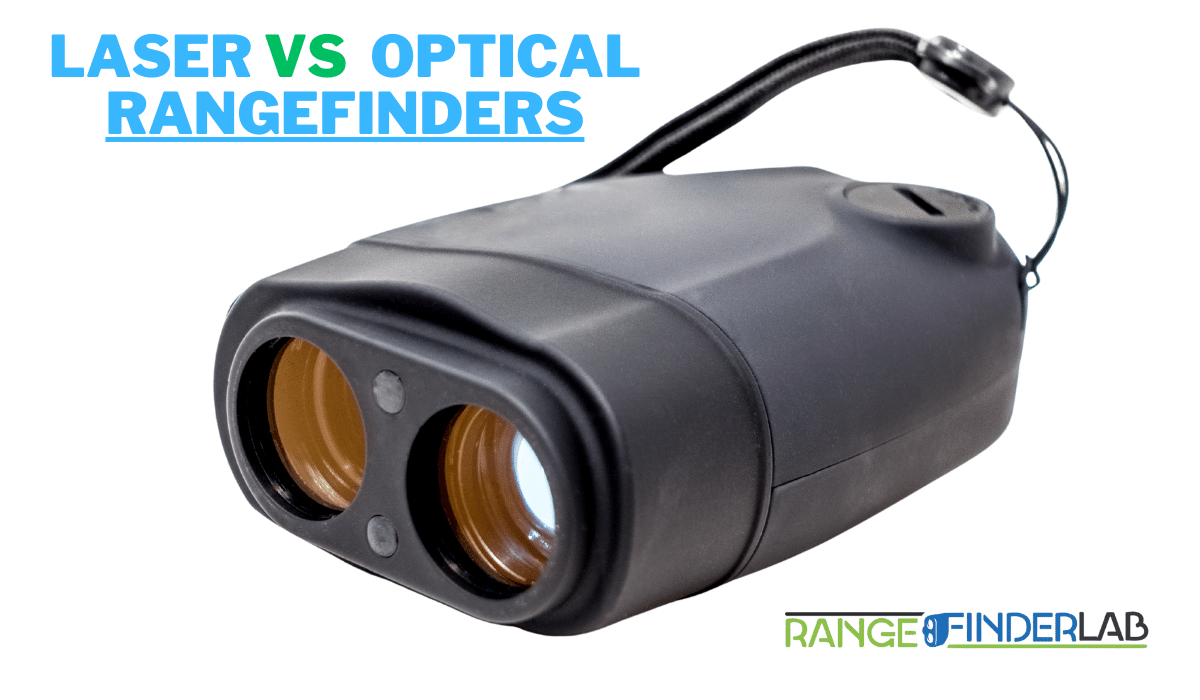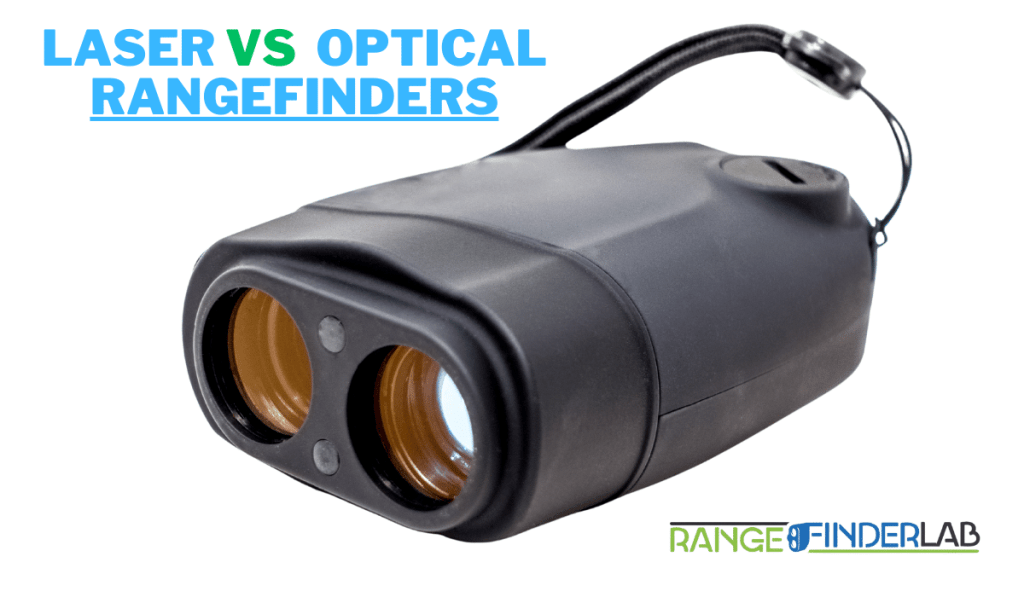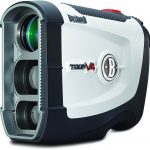

Rangefinders have revolutionized the way we measure distances, whether for recreational, professional, or military purposes. At their core, rangefinders are devices that help determine the distance from the observer to a target, a function vital in various fields like golfing, hunting, photography, and surveying. The two primary types of rangefinders are laser and optical, each with unique characteristics and functionalities.
In today’s world, where technology offers multiple solutions for a single problem, understanding these differences becomes more than a matter of preference. It’s about making an informed choice that aligns with one’s needs and situations. Whether you are a professional surveyor, a sports enthusiast, or someone interested in the mechanics of distance measurement, knowing the nuances between laser and optical rangefinders is crucial. This knowledge not only aids in making a more informed purchasing decision but also enhances the user experience by aligning expectations with the device’s capabilities.
This comprehensive article will delve into the workings, advantages, and disadvantages of both laser and optical rangefinders. We aim to provide a clear, detailed comparison to help you understand which type of rangefinder best suits your needs. So, let’s embark on this informative journey to demystify these two technologies and discover what sets them apart.
Table of contents
Understanding Rangefinders
Basic Concept of a Rangefinder
A rangefinder is a device that measures the distance from the observer to a target. The fundamental principle behind a rangefinder is straightforward: it determines the range, or distance, between two points. However, the method of measuring this distance can vary significantly depending on the type of rangefinder.
The primary function of any rangefinder is to provide accurate distance measurements. This is achieved through different technologies, the most common being optical and laser-based systems. Optical rangefinders typically use manual methods to calculate distance, such as triangulation, where angles and known baselines are used to determine the range. In contrast, laser rangefinders emit a laser beam toward the target; the time it takes to reflect is used to calculate the distance.
History and Evolution of Rangefinders
The history of rangefinders is a fascinating journey through innovation and technological advancement. The earliest forms of rangefinders can be traced back to the 19th century, and they were used primarily in military applications to determine the range of targets. These initial rangefinders were predominantly optical, relying on visual techniques to estimate distances.
Significant milestones have marked the evolution of rangefinders over the years. In the early 20th century, rangefinders saw advancements by incorporating stereoscopic and coincidence methods, enhancing accuracy and usability. These devices were crucial in both World Wars and used extensively in artillery, naval warfare, and aerial surveillance.
Post-World War II, the development of rangefinders took a turn towards more civilian applications. The invention of laser technology in the 1960s introduced a new era for rangefinders. Laser rangefinders, utilizing the speed of light to measure distances, brought unprecedented accuracy and ease of use. This technology quickly entered various fields, including golf, hunting, surveying, and photography.
The late 20th and early 21st centuries witnessed a rapid advancement in rangefinder technology, driven by digital electronics and computing. Modern rangefinders are compact, efficient, and packed with features like GPS, digital displays, and integration with smartphones and other devices. Optical rangefinders, though less common now, still hold their ground in specific applications due to their simplicity and reliability.
As we progress, rangefinders evolve, incorporating more sophisticated technology like AI and enhanced optics. Their journey from bulky, manual devices to sleek, multifunctional gadgets reflects the march of technological progress and the human quest for precision and convenience.
Laser Rangefinders
How Laser Rangefinders Work
Laser rangefinders function on the principle of time-of-flight. In simple terms, these devices emit a laser beam toward a target. When the beam hits the target, it reflects to the rangefinder. The device then calculates the time the laser beam takes to travel to the target and back. Since the speed of light is constant (approximately 299,792 kilometers per second), the rangefinder can accurately determine the distance based on this time measurement.
Most laser rangefinders incorporate advanced optics and electronics to enhance accuracy. They often include magnification, target prioritization, and sophisticated algorithms to account for variables like angle, temperature, and elevation, further refining their measurements.
Advantages of Laser Rangefinders
- High Accuracy: Laser rangefinders are known for their exceptional accuracy. They can measure distances within a few meters, even over long ranges, which is invaluable in precision-required activities.
- Long Range: They are capable of measuring much longer distances compared to optical rangefinders, with some models reaching ranges of several kilometers.
- Ease of Use: Laser rangefinders are generally user-friendly. Pointing the device at a target and pressing a button is all it takes to get a measurement.
- Versatility: These rangefinders are adaptable to various environments and applications. They can be used in diverse lighting conditions and can measure distances to a wide range of surfaces.
- Speed: Laser rangefinders provide quick results, crucial in time-sensitive scenarios like hunting or sports.
Disadvantages of Laser Rangefinders
- Dependency on Batteries: Electronic devices rely on batteries, which can be limited in remote areas or prolonged use situations.
- Weather Sensitivity: Their accuracy can be affected by weather conditions. Fog, rain, and bright sunlight can interfere with the laser beam, leading to less accurate measurements.
- Cost: Generally, laser rangefinders are more expensive than optical ones, making them a significant investment.
- Complexity: With advanced features comes a higher level of complexity, which might not be necessary for all users.
Common Applications of Laser Rangefinders
Laser rangefinders have found their place in a variety of fields, each benefiting from their precision and ease of use:
- Sports: In golf and archery, players use them to gauge distances to targets for improved accuracy.
- Hunting: Hunters rely on laser rangefinders to measure distances to the game, ensuring precise shots.
- Surveying and Construction: These devices aid in accurately measuring distances, which is crucial in planning and executing construction projects.
- Photography and Filmmaking: They help set focus distances and plan shots, especially in complex scenes.
- Military and Law Enforcement: Their accuracy and reliability are critical for target acquisition and reconnaissance.
- Recreational Activities: Outdoor enthusiasts and hikers use them to navigate and measure distances in natural landscapes.
Laser rangefinders represent a fusion of advanced technology and practical application, offering a modern solution to the age-old challenge of accurately measuring distances.
Optical Rangefinders
How Optical Rangefinders Work
Optical rangefinders, often based on the principle of triangulation, use visual techniques to estimate the distance to an object. The most traditional form of an optical rangefinder involves a user looking through a viewfinder to align two images of the target. By adjusting a dial or lever, these images are brought into alignment, and the distance is calculated based on the geometry of the rangefinder and the angle of alignment.
These devices usually have lenses at either end of the rangefinder. The difference in the view from each lens provides the angular data needed to calculate distance using simple trigonometry. This method, while more manual and less tech-intensive than laser rangefinders, has been effectively used for many years in various applications.
Advantages of Optical Rangefinders
- No Need for Power: Optical rangefinders operate without batteries or any external power source, which makes them more reliable in remote or extended outdoor situations.
- Simplicity and Durability: With fewer electronic components, optical rangefinders are typically more rugged and less prone to failure or damage in harsh environments.
- Cost-Effective: They are generally more affordable than their laser counterparts, making them accessible to a broader range of users.
- Safe and Unrestricted: Optical rangefinders don’t emit radiation or signals, making them safe and usable in all environments, including sensitive or regulated areas.
Disadvantages of Optical Rangefinders
- Limited Range and Accuracy: They are not as accurate as laser rangefinders, especially over longer distances. The range is also generally shorter compared to laser models.
- Requires Skill to Use: Accurate measurement with an optical rangefinder often requires practice and skill, as it involves manual alignment and estimation.
- Affected by Visibility: Their effectiveness is heavily dependent on visibility. Poor lighting, fog, or rain can significantly impair their performance.
- Fewer Features: Optical rangefinders typically lack the advanced features and conveniences found in modern laser rangefinders, like digital readouts, integration with other devices, and target prioritization.
Typical Applications of Optical Rangefinders
Despite these limitations, optical rangefinders have their place in various fields:
- Historical and Educational Use: They are often used in educational contexts to teach the basics of optics and triangulation.
- Recreational Activities: Outdoor activities like hiking or basic orienteering offer a simple and reliable way to estimate distances.
- Budget-Conscious Sports: An optical rangefinder can be a cost-effective alternative in sports like golf or archery, where the distances involved are shorter.
- Photography: Some photographers prefer them for their simplicity and control in manually estimating distances.
- Military and Historical Reenactments: Due to their historical significance, they are sometimes used in military reenactments or by enthusiasts of historical military equipment.
Optical rangefinders represent a more traditional approach to distance measurement. While they may lack the high-tech features of laser rangefinders, their simplicity, reliability, and cost-effectiveness continue to make them a viable choice for various applications.
Comparative Analysis
Direct Comparison of Laser and Optical Rangefinders
Understanding their fundamental differences is crucial when choosing between laser and optical rangefinders. Here’s a direct comparison:
- Accuracy and Range: Laser rangefinders are superior in accuracy and range. They can accurately measure long distances, often up to several kilometers, with a minimal margin of error. Optical rangefinders, while reasonably accurate, are limited in range, and their accuracy diminishes over longer distances.
- Ease of Use: Laser rangefinders are generally easier to use. They often involve simply pointing at a target and pressing a button, with the device doing most of the work. Optical rangefinders require more skill and experience to manually align images and estimate distances.
- Dependence on Power and Weather Conditions: Laser rangefinders rely on batteries, which can be limited in remote areas. They are also more susceptible to adverse weather conditions like fog or rain, which can affect the laser beam. Optical rangefinders, being purely mechanical, are not affected by these factors.
- Cost and Features: Laser rangefinders are typically more expensive and have additional features like digital displays, smartphone integration, and enhanced optics. Optical rangefinders are more budget-friendly and have a straightforward, no-frills design.
- Durability and Maintenance: With fewer electronic components, optical rangefinders are generally more durable and require less maintenance than laser rangefinders.
Use-Cases and Suitability
- Sports (Golf, Archery): Laser rangefinders are preferred for their accuracy and ease of use. They can quickly provide precise distance measurements, which is crucial in sports.
- Hunting and Outdoor Activities: Laser rangefinders are favored for their ability to measure long distances accurately and quickly, which is vital for tracking and hunting in vast open spaces.
- Surveying and Construction: Laser rangefinders’ precision and long-range capabilities make them ideal for professional surveying and construction work.
- Photography and Filmmaking: While laser rangefinders offer quick and accurate measurements, some photographers and filmmakers might prefer optical rangefinders for their manual control and traditional feel.
- Educational and Recreational Use: Optical rangefinders are a suitable choice for those who enjoy the basics of navigation and distance measurement or are on a budget.
- Military and Tactical Applications: Laser rangefinders are often used for their precision and advanced features. However, in situations where electronic signals are a concern, optical rangefinders may be preferred.
In conclusion, the choice between laser and optical rangefinders largely depends on the user’s specific needs. Laser rangefinders excel in accuracy, ease of use, and advanced features but come at a higher cost and with some limitations regarding weather dependency and power requirements. Optical rangefinders, while less precise and more manual, offer reliability, durability, and independence from power sources, making them suitable for specific applications and preferences.
Expert Opinion
As an expert in the field of rangefinders, my experience with laser and optical rangefinders has given me a unique perspective on their applications and technological nuances.
Personal Insight and Experience with Laser and Optical Rangefinders
My journey with rangefinders began with the classic optical models. Their manual operation and reliance on basic optical principles offered a deep understanding of the fundamentals of distance measurement. The satisfaction derived from manually aligning images and calculating distances is unparalleled. However, the limitations in terms of range and accuracy were noticeable, especially in scenarios requiring precise measurements.
Transitioning to laser rangefinders was a leap into modern technology. The immediate difference was the ease of use – a simple button press yielded an accurate distance reading within seconds. The precision and range of laser rangefinders are exceptional. I’ve used them in various settings, from golf courses to vast wilderness areas for wildlife observation. Even over long distances, their reliability provided confidence and efficiency that optical rangefinders couldn’t match.
Unique Perspective on the Technology and Its Applications
From a technological standpoint, laser rangefinders are a testament to how advancements in electronics and optics can revolutionize a simple concept like distance measurement. The integration of features such as angle compensation, target prioritization, and connectivity with other devices showcases the versatility of this technology.
However, I believe there’s still a place for optical rangefinders, particularly in their educational value and the ‘pure’ experience they offer. They teach patience and precision and provide a deeper appreciation for the physics behind distance measurement. Optical rangefinders are a valuable tool for hobbyists, enthusiasts, and those in situations where simplicity and reliability are paramount.
The choice between laser and optical rangefinders should be dictated by the user’s specific needs and context. Laser rangefinders are the clear choice for professionals and enthusiasts who require precision and efficiency. However, the traditional optical rangefinder offers an irreplaceable charm for those engaged in activities where the process and measurement experience are as important as the outcome.
In conclusion, while laser rangefinders represent the pinnacle of convenience and accuracy in modern rangefinding, optical rangefinders remind us of the origins and fundamentals of this technology. Both have their unique place and role, serving different needs and preferences in the diverse world of distance measurement.
Frequently Asked Questions (FAQ)
1. Can weather conditions affect the performance of laser rangefinders?
Yes, laser rangefinders can be affected by adverse weather conditions. Heavy rain, fog, or very bright sunlight can interfere with the laser beam, potentially leading to less accurate measurements. Optical rangefinders, being non-electronic, are generally less affected by weather conditions.
2. Are laser rangefinders safe for the eyes?
Most consumer-grade laser rangefinders are designed to be safe for the eyes. They typically use Class 1 lasers, which are considered safe under all everyday use conditions. However, it’s always essential to use them as directed and avoid direct eye exposure to the laser beam.
3. How important is the magnification factor in rangefinders?
Magnification is an important feature, especially in laser rangefinders, as it helps accurately target objects at a distance. Higher magnification can provide a clearer view of the target but may also make the device more susceptible to hand movements. Typically, a magnification of 4x to 7x is sufficient for most applications.
4. Can rangefinders be used for both day and night?
Laser rangefinders can typically be used in day and night conditions, although their effectiveness might vary based on the device’s quality and environmental factors. Optical rangefinders, relying on visual estimation, are generally more suited to daytime use.
5. What is the lifespan of a typical laser rangefinder?
The lifespan of a laser rangefinder depends on its build quality, usage, and maintenance. With proper care, a good quality laser rangefinder can last many years. Regular battery changes and careful handling are essential for a prolonged lifespan.
6. Do optical rangefinders require calibration?
Optical rangefinders are less complex than laser models and usually do not require frequent calibration. However, checking their accuracy periodically is good practice, mainly if used for critical measurements.
7. Are there any legal restrictions on using laser rangefinders?
In most cases, there are no legal restrictions on using laser rangefinders for civilian purposes like sports, hunting, or photography. However, it’s always advisable to check local regulations, especially when using them in sensitive areas or for specific professional applications.
Conclusion
In this comprehensive exploration of laser and optical rangefinders, we’ve delved into how these devices work, their advantages and disadvantages, and their suitability for various applications. We’ve seen that the choice between a laser and an optical rangefinder is not a matter of which is universally better but is more appropriate for your specific needs and circumstances.
To summarize the key points:
- Laser Rangefinders excel in precision, ease of use, and range capabilities. They are the go-to choice for activities requiring high accuracy over long distances, such as sports, hunting, and professional surveying. However, they come with a higher price tag, dependency on power, and potential limitations in adverse weather conditions.
- Optical Rangefinders, on the other hand, offer simplicity, durability, and independence from power sources. They are more affordable and ideal for educational purposes, recreational activities, and situations where electronic devices might be restricted. Their limitations lie in reduced accuracy, range, and a higher skill threshold for practical use.
Final Thoughts and Recommendations:
- Assess Your Needs: Consider what you need the rangefinder for – is it for casual or professional use, short-range or long-range measurements, in varied weather conditions, or for specific activities like golfing, hunting, or surveying?
- Budget Considerations: If cost is a significant factor, optical rangefinders offer a more affordable option. However, investing in a laser rangefinder is worthwhile if you require accuracy and advanced features.
- Skill Level and Ease of Use: Laser rangefinders are more suitable if you prefer a straightforward, easy-to-use device. If you enjoy the challenge and skill involved in manual measurements, an optical rangefinder might be more fulfilling.
- Consider Long-Term Use: Consider durability, maintenance, and the potential need for batteries. An optical rangefinder’s durability could be advantageous if you anticipate frequent, rugged use.
- Stay Informed: As technology advances, so do the capabilities of these devices. Keep an eye on new developments that might better suit your evolving needs.
In conclusion, laser and optical rangefinders have unique strengths and applications. By understanding these differences and considering your specific requirements, you can make an informed decision that enhances your professional recreational activities or somewhere in between.








